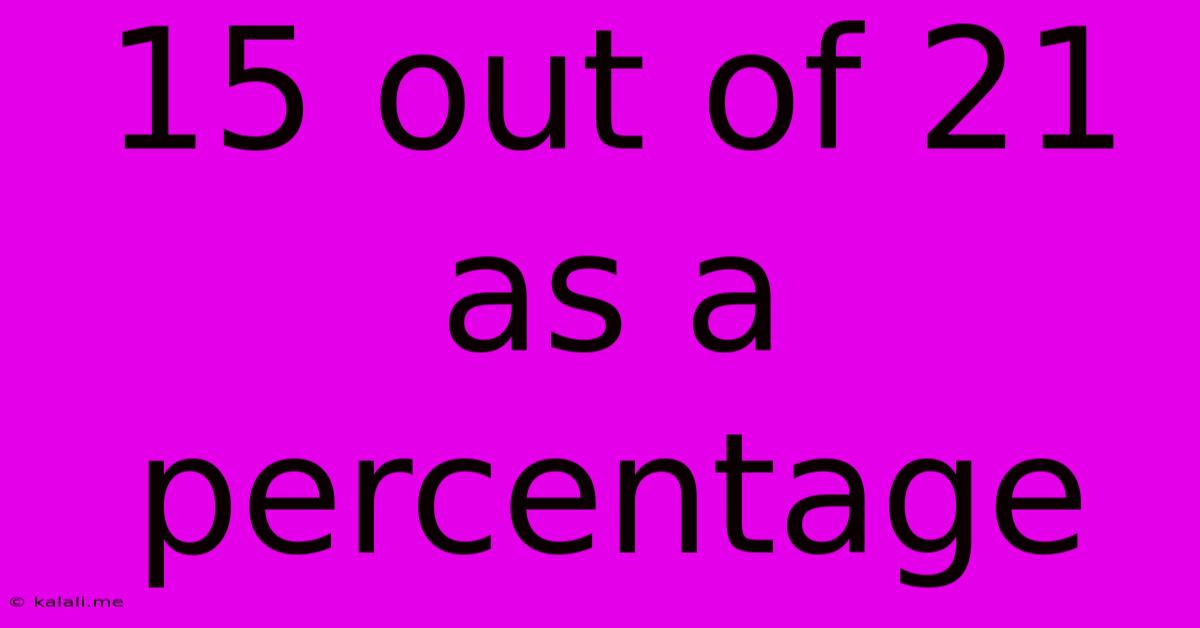15 Out Of 21 As A Percentage
Kalali
May 10, 2025 · 3 min read

Table of Contents
15 out of 21 as a Percentage: A Simple Guide to Calculating Percentages
Want to know how to calculate 15 out of 21 as a percentage? Understanding percentages is a crucial skill in many aspects of life, from calculating discounts to understanding statistics. This guide will walk you through the simple steps to solve this, along with some helpful tips and tricks for calculating percentages in the future.
What does "15 out of 21" mean?
This phrase represents a fraction: 15/21. To convert this fraction to a percentage, we need to express it as a proportion of 100. Think of a percentage as simply parts per hundred.
Step-by-Step Calculation:
-
Divide the numerator by the denominator: The first step is to divide the numerator (the top number, 15) by the denominator (the bottom number, 21). This gives us: 15 ÷ 21 = 0.7142857...
-
Multiply by 100: To convert the decimal to a percentage, we multiply the result by 100. This is because a percentage is always expressed out of 100. So, 0.7142857... x 100 = 71.42857...
-
Round to the desired precision: The result is a repeating decimal. You'll likely want to round this to a manageable number of decimal places. Rounding to one decimal place, we get 71.4%. Rounding to the nearest whole number, we get 71%.
Therefore, 15 out of 21 is approximately 71.4%.
Understanding Percentage Calculations: Tips and Tricks
-
Using a calculator: Calculators make percentage calculations incredibly easy. Simply divide the numerator by the denominator, then multiply by 100. Most calculators have a % button that automates this process.
-
Simplifying Fractions (optional): Before performing the division, you can simplify the fraction 15/21 by finding the greatest common divisor (GCD). The GCD of 15 and 21 is 3. Dividing both the numerator and denominator by 3 simplifies the fraction to 5/7. Then, proceed with the division and multiplication as described above. This simplification can make the calculation easier, especially for larger numbers.
-
Estimating Percentages: For quick estimations, you can use benchmarks like 1/4 = 25%, 1/2 = 50%, and 3/4 = 75%. For example, since 15/21 is a bit more than 14/21 (which simplifies to 2/3, approximately 67%), it makes sense that the percentage is slightly above 67%.
-
Practical Applications: Understanding percentages is vital in many real-world scenarios, such as:
- Calculating discounts: Finding the price of an item after a percentage discount.
- Determining tax amounts: Calculating the tax added to a purchase price.
- Analyzing data: Interpreting statistical data represented as percentages.
- Understanding financial reports: Analyzing financial statements with percentage changes.
Conclusion
Calculating 15 out of 21 as a percentage is a straightforward process involving simple division and multiplication. Mastering this fundamental skill allows you to confidently tackle various percentage-related problems in your daily life and professional endeavors. Remember to use a calculator for ease and accuracy, and feel free to simplify fractions beforehand if needed. Now you can confidently convert fractions to percentages and apply this knowledge to various situations.
Latest Posts
Latest Posts
-
How Much Is 1000 Hours In Days
Jul 06, 2025
-
Sic A Parrot On The Guild Emissary
Jul 06, 2025
-
How Many Slices Of Turkey Is 3 Oz
Jul 06, 2025
-
Which Word Best Describes The Tone Of The Passage
Jul 06, 2025
-
How Long Does It Take To Count To One Billion
Jul 06, 2025
Related Post
Thank you for visiting our website which covers about 15 Out Of 21 As A Percentage . We hope the information provided has been useful to you. Feel free to contact us if you have any questions or need further assistance. See you next time and don't miss to bookmark.